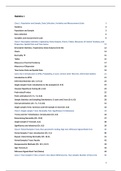Samenvatting
Statistics 1 - Full summary
- Vak
- Statistics 1
- Instelling
- Rijksuniversiteit Groningen (RuG)
Full summary of all the aspects dealt with during Statistics 1. Also includes information from the book 'Elementary statistics for geopgraphers' and my own notes.
[Meer zien]




